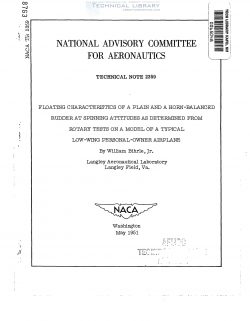naca-tn-2359
- Version
- 132 Downloads
- 2.19 MB File Size
- 1 File Count
- December 14, 2016 Create Date
- December 14, 2016 Last Updated
National Advisory Committee for Aeronautics, Technical Notes - Floating Characteristics of a Plain and a Horn Balanced Rudder at Spinning Attitudes as Determined from Rotary Tests on a Model of a Typical Low Wing Personal Owner Airplane

An investigation was conducted to determine the floating
characteristics of full—length plain and horn-balanced rudders during
rotary tests at spinning attitudes on a %-scale model of a typical
low-wing personal-owner airplane. The investigation also included the
determination of the effects of the horizontal tail and the wing on
the rudder floating characteristics.
The results indicated that the rudder was in the wake of the
stalled wing and oscillated violently for the spinning angle—of—attack
range from 350 to 55° and that at lower spinning angles of attack the
horn-balanced rudder had more desirable floating characteristics than
the plain rudder. Neither the plain nor the horn-balanced rudder
would fulfill the rudder-deflection requirement fbr satisfactory spin
recovery with controls released as determined from available free-
spinning model data. The results also indicated that, if the tail
was not in the wake of the wing, the hornrbalanced rudder"had more
favorable floating characteristics than the plain rudder through a
large spinning angle-of—attack range for a normal sideslip-angle
range. It was shown that horizontal—tail interference led to an
appreciable difference between floating angles obtained from static
data and from rotary data.
A study of available rudder hinge-moment-coefficient data was
made in reference 1 to determine the floating characteristics of
various typesof rudders in spinning attitudes. The study was made
because Civil Air Regulations (reference 2) in force at the time the
study was initiated required spin recovery of personal-owner airplanes
with controls released. In order to comply with these regulations, the‘
floating characteristics of a rudder, for any given tail design, would
have to be such that the control surface would float against the spin
to a position required for satisfactory recovery. Results of free-
spinning tests on personal-owner airplane designs (reference 3) indi-
cated that, in general, the rudder must float to large deflections
against the spin to ensure satisfactory recovery.
Reference 1, which consisted of limited static hinge-moment data
available at spinning attitudes, indicated that the plain rudder had
undesirable floating characteristics as regards spin recovery and that
use of a horn-balanced rudder appeared promising. Inasmuch as the
available data were limited and the reliability of static data in
predicting rudder floating characteristics during a spin was not known,
the present investigation was made to determine floating character-
istics from extensive rotary tests at spinning attitudes. For this
investigation, rudder floating angles were measured during rotation
of a typical lowewing personal-owner airplane model at spinning
attitudes with full-length (part of the rudder extends below the
horizontal tail) plain and horn-balanced rudders.
| File | Action |
|---|---|
| naca-tn-2359 Floating Characteristics of a Plain and a Horn Balanced Rudder at Spinning Attitudes as Determined from Rotary Tests on.pdf | Download |

Comment On This Post